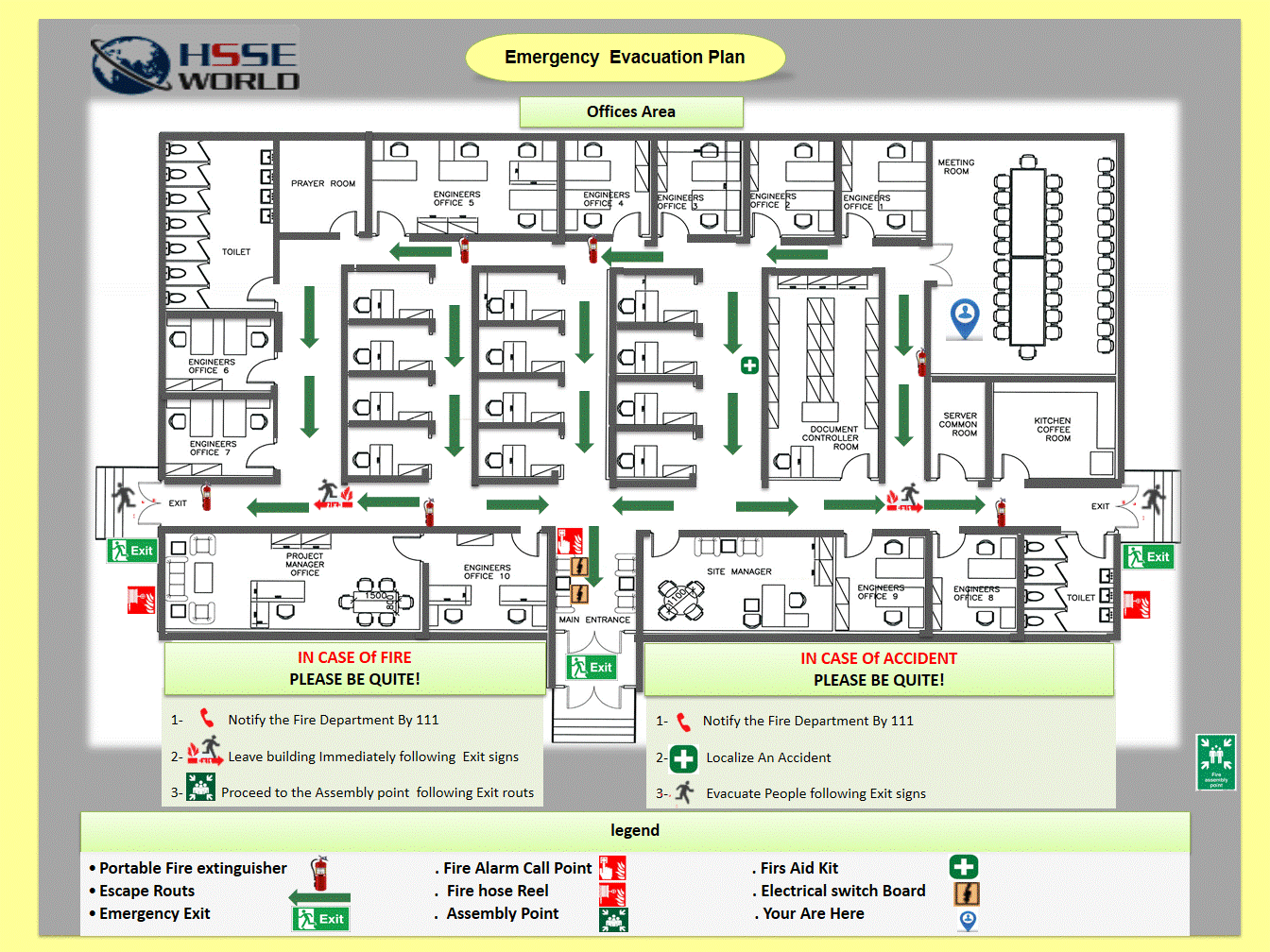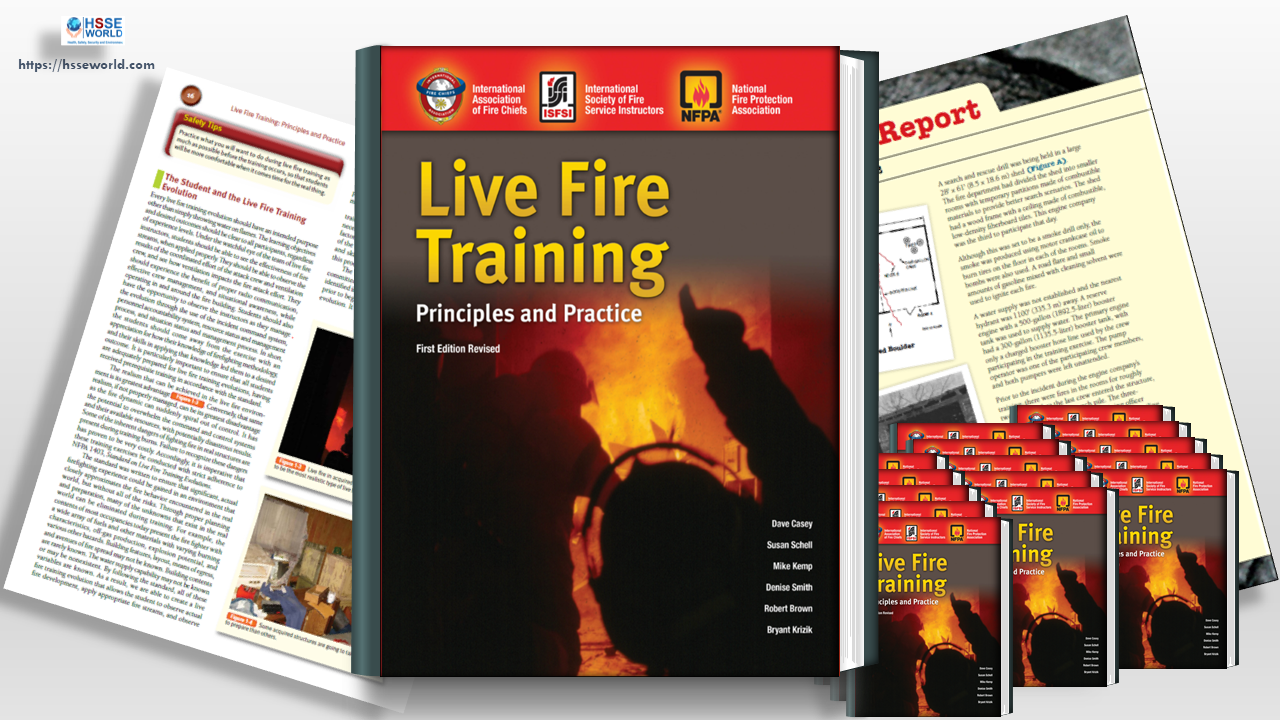In this article, we will speak on the Fire Alarm System and present some Questions followed by their Answers useful for your interview preparation required for the job as a Fire and Gas System Engineer.

What is a fire alarm system?
Per the definition in NFPA 72: A system or portion of a combination system that consists of components and circuits arranged to monitor and annunciate the status of a fire alarm or supervisory signal-initiating devices and to initiate the appropriate response to those signals
What are the Basic Components of a Fire Alarm System?
- Control Panel
- Communications
- Initiating Devices
- Notification Appliances
What is Fire Control Panel?
A component of the fire alarm system that receives signals from initiating devices and processes these signals to determine the fire alarm output functions.
What are the Communications types available in Fire Alarm System?
- DACS – Digital Alarm Communications Systems
- POTS – (Plain Old Telephone System) Loop Start with line seizure from the point of demarcation prior to sending it.
- Cable Company Service – assuming you have no CODEC, Voice Compression, or back up power issues.
- One Way/Two Way Radio – Mesh Radio and GSM
- IP Communicators with UL listings
- Sole Path Communicators with UL Listings
What are Initiating Devices in Fire System?
A system component that originates transmission of a change-of-state condition. Examples are Smoke Detector, Heat Detector, etc.
What are the Types of Sprinkler Systems?
Wet Pipe:
Since water is always present in the pipes supplying the sprinkler heads, these types of sprinkler systems are quick to react upon the operation of a sprinkler head in a fire scenario.
These are the most common systems and are used in buildings where there is no risk of freezing. Wet systems are required for multi-story or high-rise buildings and for life safety systems.
Dry pipe:
The pipes are filled with air under pressure at all times and the water is held back by the control valve outside of the protected area. Should a sprinkler head open in a fire scenario, the drop in air pressure opens the valve, and water flows into the pipework and onto the fire. Dry pipe systems are used where wet or alternate systems cannot be used.
Alternate: Alternate systems have the pipes full of water for the summer period, then subsequently drained down and filled with air for the winter. This is typically for buildings that are not heated, e.g. underground car parks.
What are Notification Appliances in Fire System?
A fire alarm system component such as a bell, horn, speaker, light, or text display that provides audible, tactile, or visible outputs, or any combination thereof. Example are Horn/Strobe, Speaker, Bell, etc
What are the different types of fire alarms?
There are two major types of fire alarms: ionization fire alarms and photoelectric fire alarms. Ionization fire alarms detect flaming, fast-moving fires – curtain fires, trash can fires, etc.
Photoelectric fire alarms are best for smoky, smoldering fires, such as electrical fires that start out behind walls.
There are also dual sensor fire alarms which, naturally, combine both types into one. To maximize your fire protection, you should install both types (or a combination of the two) to make sure you are completely covered.
What is the difference between conventional and addressable fire alarms?
Conventional fire alarms are ideal for small buildings such as homes, individual offices, or retail shops. Conventional fire alarms go off when they detect smoke in their immediate vicinity and are perfect for evacuating people from a small space.
Addressable fire alarms are more useful for large buildings or building complexes.
The biggest difference between addressable and conventional fire alarm systems is addressable fire alarms have an annunciator panel that shows you (or, more importantly, the fire department) exactly which devices are going off so you can get the proper resources to them as quickly as possible.
What is the difference between a real and a false alarm?
None. All alarms are real and are caused by a break in the electrical current passing through the alarm system. Alarms can be sounded by someone activating a pull station, by something as simple as toast burning near a smoke detector, or by an actual fire.
If an alarm sounds, something caused it. It might not be a fire, but don’t bet your life on it. All alarms should be treated as though they were caused by the fire until it can be determined otherwise by a competent authority, such as the responding Fire Department.
Over the years we have developed a dangerous complacency in response to fire alarms due to the overuse of the term “false alarm” to characterize an alarm not caused by actual fire.
What is a fire alarm?
A fire alarm system is a number of devices working together to detect and warn people through visual and audio appliances when smoke, fire, carbon monoxide, or other emergencies are present.
These alarms may be activated automatically from smoke detectors, and heat detectors or may also be activated via manual fire alarm activation devices such as manual call points or pull stations.
What should you do if I hear a fire alarm?
Evacuate your building immediately and go to the area your supervisor has designated as a meeting point. For safety reasons, you should evacuate if you hear any alarm, even if it is not in your zone.
Why do we need NFPA 72 compliance?
NFPA 72 is a prescriptive standard that applies to Fire Alarm Systems. While the NFPA 72 standard makes no mention of gas detection, many clients are applying NFPA 72 standards and requirements to both fire and gas detection systems.
There are several advantages to NFPA 72 certified systems that include:
- Allows for the combining of both fire alarm and gas detection functions into a single safety system
- Ensures that local “authorities having jurisdiction” like fire marshals or fire authorities have the assurance that the system complies with the applicable codes and standards
- Allows the end-user to lower their insurance costs because they are using a certified system
- An NFPA 72 certified solution ensures that you are complying with the best practices in the industry as drafted by the NFPA
When should we use a PLC vs. a Controller-based solution for F&G?
The choice between a PLC and Controller-based system is primarily driven by the size of the application.
PLCs are best suited for medium to large size gas detection systems (25+ points of gas detection). For very large systems, PLCs have the advantage of scaling fairly inexpensively to accommodate large point counts. PLCs offer the added benefit of extensive connectivity options for communicating with other DCS or ESD systems.
Controller-based gas detection lends itself to small to medium-sized systems very effectively. A controller-based gas detection system is relatively easy to implement and does not require software programming tools. The hardwired nature of a controller-based solution makes it inherently simple to troubleshoot and support.
What is the difference between fail-safe operation and the supervision requirements of the fire codes and NFPA 72?
The underlying principle of fail-safe design assumes that a process or item of equipment can be designed to take the process to a safe status on equipment failure or power interruption.
This approach requires that the switch to a “safe state” be possible without the power and that the “normal operating state” of the equipment utilizes energized control circuits.
Almost all detection, extinguishing, and notification circuits of a Fire Alarm system are not normally energized and are not “fail-safe”.
In order to be sure these fire circuits are intact and ready for use when needed these circuits are “supervised”. Supervision is normally done using a small current or voltage passed through a field circuit device called an “end of line device”. This small current or voltage is continuously monitored to verify that the circuit is intact and ready for operation.
Fire Alarm systems in many cases need to activate suppression or notification equipment in the event of a hazardous condition and these systems require power to be available to do so. These is the primary arguments behind the NFPA 72 requirements associated with backup power systems and batteries.
Should we take addressable fire alarm communications into process areas?
Addressable fire alarm communication devices can be used in process areas when the operating specifications of the devices are compatible with the electrical and environmental conditions found in these process areas.
Most commercial addressable fire alarm equipment is normally rated for operation in general-purpose environments with ambient temperatures between 0 and 50°C. Most process area environments have operating temperature ranges outside the 0-50°C range. Many process area environments require devices suitable for Division 1 or Division 2 areas.
When using commercial addressable fire alarm equipment we normally recommend that the addressable equipment be located only in environmentally controlled areas such as crew quarters, control rooms, office areas.
If devices to be connected to the addressable fire alarm system are to be located outside these environmentally controlled areas, we recommend the use of an addressable to conventional circuit converter to be installed inside the environmentally controlled area with a conventional circuit interface to the process area located device.
What is a ‘fire triangle’?
A fire triangle represents the three elements, which causes a fire in a combustible mixture. The three elements are fuel, air, and ignition.
What is the importance of a ‘hood’ on a gas turbine?
During a gas turbine normal running condition, a hood provides:
a.prevention of turbine high dB noise to outside areas
b.keeps the gas turbine clean from external dust
c.provides a draft for the gas leak to the exhaust through the hood fan
During a gas turbine shutdown condition a hood provides:
a.cooling the turbine body by way of the hood fan
b.During a fire shutdown it facilitates to put out the fire by confining the fire extinguishers on the gas turbine.
Why do we use ‘Halon’ as a fire extinguisher in a gas turbine hood?
Halon is stored in liquid form in a cylinder. When it is released in a hood during the occurrence of the fire, it discharges the halon in gas. Halon does not act or react to electrical components.
What is the expansion from of B.C.F?
The expanded form of B.F.C is Bromo chloro floride.
In a Ruston gas turbine, why are there two Halon cylinders in each bank? How do they function?
The first bottle is the ‘first shot’ and the second bottle is ‘Extended shot’.
The first bottle discharges the Galon into the hood through a 1’’ pipe in approximately 15 seconds, whereas the extended bottle discharges the Halon through a ¼’’ pipe for another ½’’hour period to maintain the inert atmosphere.
How many UV detectors are installed in Solar, Ruston TB-5000, and Ruston TA-1750 gas turbine hoods?
Solar gas turbine hood: 4 UV detectors
Ruston TA-1750 hood: 4 UV detectors
Ruston TB 5000 hood: 12UV detectors
What is the voting Logic of UV detectors in Soar and Ruston gas turbines?
There are two voting logics, they are: 1 out of 4 UV s and 2 out of 4 UV s
What happens when UV detectors detect a fire?
1out of 4 UV s: creates annunciation, the audible alarm on the control panel, and siren in the field (refer to the station drawings for the exact function and operations).
2 out of 4 UV s: creates annunciation, the audible alarm on the control panel, a siren in the field, the shutdown of the turbine, and release of the fire extinguisher (refer to the station drawings for the exact function and operations).
How much is the time delay between fire sensing by a UV detector and confirming with an alarm?
Generally, it is set for 4 secs. The UV detectors initiate a fire alarm only when the UV is detecting the fire continuously for 4 secs (refer to the station drawings for the exact settings parameters).
What are the Halon manual release facilities available on a Solar gas turbine?
Auto Halon cylinder can be discharged manually from the fire & gas control panel in the control room. On initiating the manual release:
a.The unit shuts down.
b.The auto Helon cylinder gets discharged in the hood.
c.Auto halon discharge confirmation and the auto Halon cylinder pressure low alarm appears on the control panel.
d.Audible alarm in the control room and siren in the field occurs.
A Manual Halon cylinder can be discharged manually from the field through a pall string. On initiating the manual release:
a.The unit shuts down.
b.The manual Halon cylinder gets discharged in the hood.
c.Manual Halon discharge confirmation and the manual Halon cylinder pressure low alarm appears on the control panel.
d.Audible alarm in the control room and siren in the field occurs.
Why are there ‘heat switches’ inside the hood, when there are UV detectors?
Heat switches are a mechanical type and they are considered to be a positive type of fire detection system.
The heat switch settings are much higher than the hood temperature.
What may be the reasons if a unit shutdown on false heat detected alarm?
The reason could be:
a.Hood ventilation fan has failed or stopped.
b.Major hot gas leak inside the hood.
What happens when a heat switch actuates?
On detection of heat, the heat switch initiates the following.
Annunciation, audible alarm on the control panel, a siren in the field, shut down of the turbine, and release of fire extinguisher (refer to the station drawings for the exact settings parameters).
Explain the operating principle of a gas monitor?
The gas monitor measures the imbalance in the current loop caused by its active and in-active filaments in the presence of combustible gas.
Explain the calibration procedure of a gas monitor system.
- Gas sensor loop current or voltage at the sensor head is set as per the manufacturer’s recommended value.
- Gas monitor zero is adjusted to the instrument air.
- A test gas with a known quantity of combustion gas (Generally methane 2% by volume) is fed to the sensor and the span is adjusted to read 40% on the monitor scale (refer to the station drawings for the exact settings parameters).
- The calibration procedure is repeated until the zero and span reads correctly.
What is the alarm and shut down setting on a gas monitor?
Generally, on the gas monitor, the alarm is set at 20%rising and the shut down is set at 60%rising (refer to the station drawing for the exact settings parameters)
What has to be done prior to entering a gas turbine hood?
Prior to entering a gas turbine, turn on the ‘ventilation defeat switch’.
What is a ventilation defeat switch?
On activating, the ventilation defeat switch inhibits the release of Halon in the auto mode and also the unit shutdown on ‘ventilation failure’.
How much is the delay between fire detection and Halon release? Why is the time delay required?
A time delay of 15 secs. Is set between the detection of fire and the initiation of Halon release.
This is to achieve effective fire extinguishing by allowing the hood fan to run-down to zero speed and the bleed valves to release the compressed air.
What does a hood ventilation fan do when a fire is detected? And why?
On detection of fire, the fire system initiates the hood fan shutdown. This is to minimize the presence of air in the hood for releasing the extinguisher.
What is hydrostatic testing on a fire extinguisher?
The dry chemical contents inside your fire extinguisher are kept under pressure over long periods of time, which can eventually cause damage to the extinguisher shell.
To ensure the shell, hose, and nozzle have no defects, whether due to metal fatigue or other causes, the extinguisher shells are emptied, filled with colored water, and brought up to a specified pressure over a short period of time (typically 30 seconds).
The shell must be able to hold that pressure for one minute (or the time specified by the manufacturer’s maintenance procedures) while the cylinder is inspected for signs of stress, leaks, bulging, and other indications of metal fatigue. Hoses on some extinguishers must also be hydro-statically tested.
How do fire sprinkler systems work?
Most conventional sprinkler heads use a small, liquid-filled bulb that acts as a plug to prevent water from escaping out of the sprinkler. Extreme heat causes this liquid to expand, eventually causing the bulb to burst and release the water behind it.
The liquid inside the bulbs comes in a variety of colors, and each color represents the temperature required to activate the sprinkler.
How does fire suppression work?
In order to burn, fire requires a chemical reaction involving heat, oxygen, and fuel. Fire suppression work by disrupting either the chemical reaction or one of the elements involved in the fire.
Numerous different fire suppression systems exist, each of which attacks a fire from a different angle and each of which has advantages and disadvantages in different environments.
What is a clean agent?
Clean agents extinguish fires using an electrically non-conductive gas. This makes them uniquely suited to protecting sensitive electronic equipment and other high-value assets present in your building.
Clean agent fire suppression systems are ideal for extinguishing fires in small spaces such as cabinets or the inside of equipment as well as for large-scale applications such as semiconductor facilities or data centers.
Clean agents do not leave behind a residue, eliminating the need for time-consuming cleanup.



